Bapaume
| Bapaume | ||
|---|---|---|
|
The Town Hall | ||
| ||
 Bapaume | ||
|
Location within Hauts-de-France region 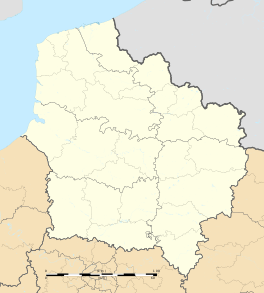 Bapaume | ||
| Coordinates: 50°06′16″N 2°51′07″E / 50.1044°N 2.8519°ECoordinates: 50°06′16″N 2°51′07″E / 50.1044°N 2.8519°E | ||
| Country | France | |
| Region | Hauts-de-France | |
| Department | Pas-de-Calais | |
| Arrondissement | Arras | |
| Canton | Bapaume | |
| Intercommunality | Sud Artois | |
| Government | ||
| • Mayor (2014–2020) | Jean-Jacques Cottel | |
| Area1 | 5.76 km2 (2.22 sq mi) | |
| Population (2010)2 | 4,115 | |
| • Density | 710/km2 (1,900/sq mi) | |
| Time zone | CET (UTC+1) | |
| • Summer (DST) | CEST (UTC+2) | |
| INSEE/Postal code | 62080 / 62450 | |
| Elevation |
108–137 m (354–449 ft) (avg. 122 m or 400 ft) | |
|
1 French Land Register data, which excludes lakes, ponds, glaciers > 1 km² (0.386 sq mi or 247 acres) and river estuaries. 2 Population without double counting: residents of multiple communes (e.g., students and military personnel) only counted once. | ||
Bapaume French pronunciation: [] is a French commune in the Pas-de-Calais department in the Hauts-de-France region of northern France.
The inhabitants of the commune are known as Bapalmois or Bapalmoises.[1]
Geography
Bapaume is a farming and light industrial town located some 23 km south by south-east of Arras and 50 km north-east of Amiens. Access to the commune is by the D917 road from Ervillers in the north which passes through the commune in a zig-zag then continues south-east to Beaulencourt. The D930 goes east by north-east to Frémicourt. The D929 branches off the D917 at the edge of the commune and goes south-west to Warlencourt-Eaucourt. The A1 autoroute passes south down the eastern edge of the commune but there is no exit in or near the commune.[2]
The Bapaume threshold
Bapaume has been called the Seuil de Bapaume (Bapaume threshold) due to its position as a crossing point between Artois and the Flanders plain on one side, and the Somme valley and the Paris Basin on the other. From the mid-11th century there was a Bapaume toll which was revised in 1202 and again in 1442.
Many roads pass through Bapaume, both old roads between the two regions then the autoroute (1965) and the TGV (1993). In the 19th century, however, the city council opposed the passage through its territory of the Paris-Lille railway.
This position was regretted by 1859 when the municipality called for the construction of a railway linking Achiet-le-Grand (on the Paris-Lille route) to Bapaume with animal traction (possibly they were afraid of steam). The railway linking the two communes was not commissioned until 1871, with steam traction. The TGV came to the town in 1993.
Neighbouring communes and villages[2]
 |
Biefvillers-lès-Bapaume | Favreuil | Frémicourt |  |
| Grévillers | |
Bancourt | ||
| ||||
| | ||||
| Ligny-Thilloy | Gueudecourt | Riencourt-lès-Bapaume |
Toponymy
Bapaume (Batpalmen or Bapalmen in Flemish[3]) means "beat your palms" in the sense of "suffering" because of the poverty of the land or some past devastation.[4]
History

Early Bapaume
The current city is not in its original location. During the Gallic period the town was located some 1500 m to the west near an abundant source: the source of the Sensée river. During the Roman Empire the town prospered as it was next to the road linking Bavay to Amiens. This period lasted about three centuries.
The barbarian invasions of 255-280 totally destroyed this first Bapaume.
Under the Late Roman Empire the city was rebuilt in the same place by Batavi settlers who were enlisted as soldier-farmers. Defensive mounds were built around the site of the current Bapaume and the road from Arras to Saint-Quentin and Péronne was diverted to pass near the defences.
This town was called Helena and was the place where Aetius repulsed the Frankish invasion attempt in 448. This invasion was successful in 454 and ended the Roman presence. During the following centuries the city was devastated several times. The Franks built a castle on the Roman mound as the area was inhabited by bandits who hid in the Arrouaise forest. A bandit called Bérenger seized the castle by a ruse and made his mark on it. After his death the people of Helluin (Helena) came to shelter near the fort and thus Bapaume was born. Helluin disappeared gradually. It is through several excavations at this place that traces of this city were found and its history.[5]
The Counts of Flanders

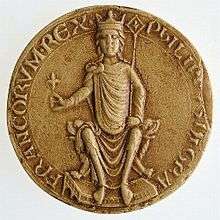
The city gradually grew in importance, the main traffic was not East-West but North-South. To ensure the passage against the bandits a toll was established by the counts of Flanders with soldiers escorting the merchants on the part crossing the Arrouaise Forest and north of the city. Churches were built with this toll. The Lords of Bapaume were subject to the Counts of Flanders.[6]
On 28 April 1180 the marriage of Philip Augustus and Isabelle of Hainaut, daughter of Baldwin V was celebrated at Bapaume. Due to this union, in 1191 Bapaume was placed under the control of the King of France.[7]
The Kingdom of France and the County of Artois
Philip Augustus returned several times to Bapaume to grant communal charters. The city became independent with the construction of a town hall with a belfry, the creation of a coat of arms and a seal, and a citizens' militia. In 1202 the toll was first revised then a second time in 1291. It was Louis IX of France, in 1237, who attached Bapaume to the County of Artois from under the thumb of Robert d'Artois, his brother, provided it paid homage to the kings of France. The city enjoyed a period of prosperity from the toll and its fine linen weaving (Batiste) by mulquiniers[Note 1] in the countryside. Robert I, Count of Artois was succeeded by Robert II, Count of Artois then Mahaut, Countess of Artois as head of the County of Artois. The nephew of Mahaut called himself Robert III of Artois and claimed the throne for a long time and, in revenge, helped the English. There followed a long period of war and disasters.
-

Robert I
-

Robert II
-

Mahaut of Artois
-

Robert III and King Edward III
Countess Mahaut often resided at the castle as she traveled frequently. She had her own room there and undertook numerous fortification works. On her death Bapaume passed to the Count of Flanders in 1330. He undertook major works including a surrounding wall and large ditches around the city in 1335. The entire castle and city was one of the most beautiful fortresses and was called the "Key of Artois".[7]
The Hundred Years' War
The fortifications protected the inhabitants of Bapaume repeatedly from frightful depredations by the English in that war. The Bailiwick of Bapaume suffered terribly during this period: it is during this time that villagers hid in their muches (underground hiding places) dug in the chalky soil.
The Dukes of Burgundy
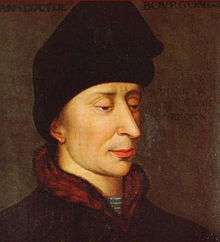
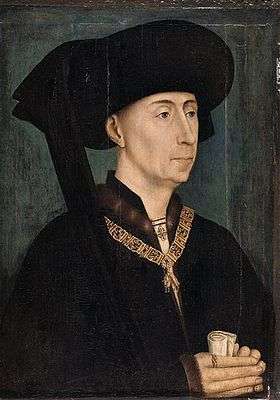
Bapaume was under the control of the Dukes of Burgundy from 1383 to 1494 and it was in this city that John the Fearless took refuge after the assassination of the Duke of Orléans in 1407. It was also at Bapaume that he reunited his army to reenter the campaign on 30 January 1414. In July 1414 the King of France laid siege to Bapaume: John's garrison surrendered without fear and Charles VI then went to besiege Arras. A peace treaty was signed on 30 August and Bapaume was given to John the Fearless, but it was in such a state that on 3 September there were insufficient voters to elect aldermen. After the death of John, his son Philip the Good spent several days at the castle in 1420 and it was he who in 1437 granted the town of Bapaume two free fairs per year. A period of prosperity followed but on 4 April 1472 a terrible fire destroyed the city. It was then looted and burned by the troops of Louis XI on 7 May 1475 and again in 1477. In 1486 Charles VIII attacked Artois again and thus Bapaume. The area suffered much from the fighting between the Burgundians and the French. On 4 June 1488 fire caused further damage to the city.
Administration by the Netherlands
_-_Google_Art_Project.jpg)

As a result of the Treaty of Senlis of 13 May 1493 concluded between the King of France and Maximilian of Austria, Bapaume came under the rule of the House of Austria and was administered by the governors of the Netherlands and Governors appointed by the kings of Spain until 1641. A new era of prosperity began, troubled by the attempts of Governors to restrict the privileges of the city. On 23 July 1509 Mayor Philippe Leclercq obtained a written statement of the powers of Mayors and Aldermen of Bapaume.
Bapaume suffered much from the rivalry between François I and Charles V. The city was devastated by the French on 15 October 1521 and went to Charles V in the Treaty of Madrid. It was again destroyed by fire in 1543 although in the meantime the Emperor had given the order to rebuild the castle and fortifications. The region was again ravaged by the French armies in 1554.
After an attempt to take the castle by a person called Lelievre,[7] the residents of Bapaume ensured that the fortifications of the castle and the city were rebuilt in 1578. The period troubled by incursions and devastation lasted until 1598 when the Treaty of Vervins was signed on 2 May. An era of peace and prosperity followed, despite a plague epidemic in 1626, which ended in March 1635 when Louis XIII declared war on Philip IV of Spain. On 18 September 1641 Bapaume surrendered after a siege by the French army. This capitulation was highly celebrated in Paris since Bapaume was considered one of the main strongholds of Artois and Flanders.
Bapaume and the Kingdom of France
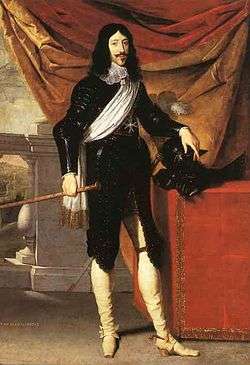

Louis XIII confirmed the powers of the city in 1642. He reinforced the fortifications that had suffered during the siege. The city and the surrounding countryside still had to suffer the presence of Spanish and French armies until 1654 (Arras was taken by Louis XIV who passed through Bapaume twice in August).
The sun king passed through Bapaume several times in 1667 while returning from Flanders. On 11 May 1670 he came to review the troops stationed near the city. On 7 May 1673 he passed the night at the castle after inspecting the fortifications.
-

Young Louis XV
-

Louis XV
In 1681 Bapaume was destroyed by fire after which it was forbidden to rebuild with thatched roofs. In 1723 a statue of Louis XV on a horse was erected in the square. This was the first statue of the young monarch in France. On 24 July 1744 the king passed through Bapaume and was highly acclaimed by the people. He again passed through the city on 6 September 1745, 2 May and 11 June 1746, and 25 September 1747.
The Fortifications


Its position subjected Bapaume to multiple wars. Defensive structures were built: first a Roman camp, then a Motte-and-bailey castle, and finally and a castle in the location of the motte. Queen Mahaut of Artois had her chamber in this castle and it seems that Joan of Arc spent one night there.
In 1335 the city itself was fortified away from the castle. These fortifications were not, however, very effective and the city was taken repeatedly. In 1540 Charles V ordered a fortified place to be built. Thick walls with bastions surrounding the city and the castle were included. In 1578 the castle and the city were united into one whole. These fortifications by Charles V were later reinforced by Vauban. Elaborate defensive systems such as mines and tunnels were built.
In 1550 Wallerand de Hauteclocque, Squire and Lord of Wail, Havernas, and Hauteclocque, was appointed by the king as lieutenant and captain of the town and castle of Bapaume.
Later Dominique de Grossolles, knight and Lord of Saint-Martin, became "Major of the town and castle of Bapaume".[8]
In the 19th century Bapaume was not considered a walled city. The dismantling of fortifications was therefore undertaken in 1847. This was done by the Army as part of maneuvres and experiments with explosives. The walls and bastions were leveled and the ditches were filled. Only the tower and part of the Dauphin bastion are still visible.
Work has been done recently to restore the underground galleries and make them available to visit: firstly, the Bastion of Reyne south-east of the city and then, on the other side, the Dauphin Bastion. These underground tunnels served as shelter during the two world wars.
-

A mine gallery in the Reyne bastion
-

Engraved stone in the Dauphin bastion
-

The Dauphin Bastion
-

Stone at the entrance of a mine network from 1551
The French Revolution
Bapaume society was transformed during the French revolution. During the Terror, the Castle was not sufficient to imprison citizens suspected of not being favourable to the Revolution. Homes vacated by residents who had fled were requisitioned to serve as prisons.
Joseph Le Bon came to the commune revive the actions of the revolutionary committee.
The city was the capital of the district from 1790 to 1795.
The Battle of Bapaume on 2 and 3 January 1871

The Battle of Bapaume was fought on 2 and 3 January 1871 during the Franco-Prussian War of 1870 on the territories of Biefvillers-lès-Bapaume and Bapaume.
General Louis Léon César Faidherbe at the head of the Northern Army stopped the Prussians.
World War I




In 1916 Bapaume was one of the cities considered to be strategic objectives by the allies in the framework of the Battle of the Somme. Bapaume was occupied by the Germans on 26 September 1914 then by the British on 17 March 1917. On 24 March 1918, the Germans took over the city again.
In 1918 the Second Battle of Bapaume, 21 August–3 September,[9] was part of the second phase of the Battle of Amiens, the British and Commonwealth attack that was the turning point of the First World War on the Western Front and the beginning of the Allies' Hundred Days Offensive. Improved armoured support and artillery bombardment weakened once impregnable positions and helped the Allied forces tear holes through trench lines. On 29 August the New Zealand Division, after heavy fighting,[10] occupied Bapaume, having broken through, with the British 5th Infantry Division, the very strong Le Transloy-Loupart trench system[11] and having overcome many other strong points around the town.
The Germans set up a trap in the town hall with a mine and a timer which exploded just before the arrival of the Australians.[12] The First Battle of Bapaume ran from 24 to 25 March 1918 and the Second Battle of Bapaume from 21 August to 3 September 1918.
After the armistice the slow and dangerous work of demining began. The city was classified as a red zone and major work was done for reconstruction. The English city of Sheffield provided assistance for reconstruction.
There remains from this time a war memorial and two military cemeteries that also have graves from the Second World War:
- The Bapaume Communal Cemetery
- The Bapaume Australian Cemetery houses the remains of 88 soldiers from 1914-18 at a place called the Pré Pot de Chart. This is a cemetery which was created in March 1917 by the 3rd Australian Casualty Clearing Station. It was closed in June 1917 then after that 23 German bodies were added in April and May 1918.
Bapaume church was demolished by shelling in 1916
World War II
During World War II Bapaume was again an area of intense fighting. The Mayor, Guidet, was a member of the Resistance and was arrested and deported to the camp of Gross-Rosen where he died on 27 November 1944.
Since 1948 there has been a monument showing the moment of his arrest to honour his memory. At the Town Hall are an urn with soil from Groß-Rosen and a painting featuring the Mayor.
Heraldry
_1a.jpg)
.svg.png) |
Blazon: Azure, 3 hands appaummee of Argent 2 and 1, the hand at dexter chief a hand sinister with 2 hands dexter. These are Canting arms. |
Administration
_1.jpg)
| From | To | Name | Party | Position |
|---|---|---|---|---|
| 1642 | Jehan Camier | |||
| 1870 | 1881 | Martial Alexandre Pajot | ||
| 1893 | 1903 | Marcelin Gaudefroy | ||
| 1920 | 1929 | Gaston Stenne | ||
| 1929 | 1940 | Abel Guidet | ||
| 1945 | 1965 | Léonce Verdel | ||
| 1965 | 1980 | Henri Guidet | ||
| 1982 | 2002 | Jean Paul Joseph Delevoye | RPR | |
| 2002 | 2004 | Anne Duez | ||
| 2004 | 2014 | Jean Paul Joseph Delevoye | UMP | |
| 2014 | 2020 | Jean-Jacques Cottel | MP (2012-?), Former Mayor of Beaulencourt (1995–2014)[14] |
(Not all data is known)
Twinning
Bapaume has twinning associations with:[15]
The pairing with Moers is the work of Henri Guidet, the son of Abel Guidet, who is involved in Franco-German reconciliation.
Demography
In 2010 the commune had 4,115 inhabitants. The evolution of the number of inhabitants is known from the population censuses conducted in the commune since 1793. From the 21st century, a census of communes with fewer than 10,000 inhabitants is held every five years, unlike larger communes that have a sample survey every year.[Note 2]
| 1793 | 1800 | 1806 | 1821 | 1831 | 1836 | 1841 | 1846 | 1851 |
|---|---|---|---|---|---|---|---|---|
| 3,492 | 3,214 | 3,084 | 3,060 | 3,189 | 3,122 | 3,210 | 3,158 | 3,265 |
| 1856 | 1861 | 1866 | 1872 | 1876 | 1881 | 1886 | 1891 | 1896 |
|---|---|---|---|---|---|---|---|---|
| 3,189 | 3,149 | 3,174 | 3,059 | 3,274 | 3,335 | 3,291 | 3,001 | 3,144 |
| 1901 | 1906 | 1911 | 1921 | 1926 | 1931 | 1936 | 1946 | 1954 |
|---|---|---|---|---|---|---|---|---|
| 3,113 | 2,946 | 2,917 | 2,112 | 2,947 | 2,782 | 2,833 | 2,748 | 3,221 |
| 1962 | 1968 | 1975 | 1982 | 1990 | 1999 | 2006 | 2010 | - |
|---|---|---|---|---|---|---|---|---|
| 3,275 | 3,575 | 3,689 | 3,524 | 3,509 | 4,331 | 4,179 | 4,115 | - |
Sources : Ldh/EHESS/Cassini until 1962, INSEE database from 1968 (population without double counting and municipal population from 2006)


Distribution of Age Groups
The population of the town is relatively old. The ratio of persons above the age of 60 years (22.1%) is higher than the national average (21.6%) and the departmental average (19.8%). Unlike national and departmental allocations, the male population of the town is greater than the female population (54.0% against 48.4% nationally and 48.2% at the departmental level).
Percentage Distribution of Age Groups in Bapaume and Pas-de-Calais Department in 2010
| Bapaume | Bapaume | Pas-de-Calais | Pas-de-Calais | |
|---|---|---|---|---|
| Age Range | Men | Women | Men | Women |
| 0 to 14 Years | 16.7 | 14.8 | 21.3 | 18.9 |
| 15 to 29 Years | 25.2 | 18.2 | 19.6 | 17.9 |
| 30 to 44 Years | 21.0 | 18.9 | 20.3 | 19.1 |
| 45 to 59 Years | 20.0 | 19.4 | 20.9 | 20.0 |
| 60 to 74 Years | 11.1 | 14.1 | 12.3 | 13.7 |
| 75 to 89 Years | 5.5 | 13.2 | 5.4 | 9.6 |
| 90 Years+ | 0.5 | 1.4 | 0.2 | 0.8 |
Sources:
- Evolution and Structure of the population of the Commune in 2010, INSEE.
- Evolution and Structure of the population of the Department in 2010, INSEE.
Economy
There is a Centre of Detention which is particularly known for being the last detention centre that hosted Lucien Léger (1937–2008) who was the oldest prisoner in France (and Europe) and stayed there for several years until his release in 2005.
Sites and monuments
The Town Hall and belfry

The town hall with its current belfry was built in 1931 and 1932 with architecture similar to the previous building built in 1610 and destroyed in 1917. The first belfry was built in the 12th century according to charters that had been issued to the city of Bapaume. Subsequently, the building became too small and aldermen obtained permission to extend it in 1374. Because of the wars that followed the belfry became dangerous and was demolished in 1537. A new belfry was started in 1583 but after many vicissitudes the building was built then destroyed and it was Philip II of Spain in 1590 who authorized the construction of a new building which was completed in 1610. It had columns and arches on the façade similar to the Arras Town Hall. For its construction the Bapaume aldermen had authorisation to establish a right of passage.
The statue of General Faidherbe

A statue of Louis Faidherbe was dedicated on 27 September 1891 and originally sculpted by Louis Noël. On 29 September 1916 the statue was requisitioned by the Germans who believed it was bronze and the statue disappeared. The pedestal, pitted by shrapnel, remained empty for 13 years. It was not until 1926 that the town decided to ask the sculptor Déchin, stepson of Louis Noël, from Paris to recreate the statue from the original plans. The new monument was inaugurated on 18 August 1929 by Paul Painlevé, Minister of War. During the redevelopment of the square in 1997 the statue was moved a few metres lower on 26 September.
Monument to Briquet and Taillandier

A monument was erected in front of the town hall in memory of Albert Taillandier and Raoul Briquet who were killed in the explosion of the Town Hall on 25 March 1917. They were both elected representatives of Pas-de-Calais but of different parties: Taillandier was a Conservative while Briquet was a Socialist. They were on an inspection mission to the front on behalf of the National Assembly of France and wished to spend the night in the building but they were trapped and killed by the explosion. Ernst Jünger wrote in his Storm of Steel that the explosion was caused by an Improvised explosive device (IED) that had been left by retreating German troops.
-

Albert Taillandier
-

Raoul Briquet
The Church of Saint Nicolas

The origin of the parish of Saint-Nicolas coincides with the origin of the town. The first church was built in 1085 when the town first became important but had disappeared by the end of the 14th century. The second church was built around the year 1600 but destroyed during the First World War. It was rebuilt on the same foundations between 1924 and 1929. The Church contains three items that are registered as historical objects:
- A Bas-relief: the Resurrection (16th century)
 [16] (disappeared in 1916)
[16] (disappeared in 1916) - A Statue: Virgin of Pity (16th century).
 [17] This statue was the only object from the Church to survive the First World War.
[17] This statue was the only object from the Church to survive the First World War. - The Organ (1934)
 [18]
[18]
The War memorial

This structure consists of a stone wall, topped by a pediment decorated with the coat of arms of the city, bordered on either side of a balustrade. Under the pediment above the three column list of soldiers killed in 1914-1918 are the words "Pro Patria" in large size followed by the text "La ville de Bapaume à ses enfants" (The city of Bapaume with her children). Further down on the side there is a standing woman with a child clearly symbolizing the widow and the orphan.[19] The woman, hair partially covered with a veil which descends down her back until mid-legs, has her right arm raised to designate a name using a palm held in her hand. She has, in a sign of protection, her left hand placed on the left shoulder of the child who, in short pants, head high, and confident, holds a beret in his right hand and holding a wreath around the left forearm. The bottom section of the monument contains a list in four columns of the missing from the 1939-1945 war.
Other sites of interest
- A Motte-and-bailey castle. Nothing is left of the old castle other than sections of wall from the fortifications of the city. The site itself has retained its crater shape and was converted into a green park and place for walking. This site is nicknamed "Le Donjon" (The Dungeon) by the people of Bapaume.
- The Australian War Cemetery has an area of 459 m2 with 88 graves from the First World War. This cemetery was opened in March 1917 by the 3rd Australian Casualty Clearing Station and used until June 1917. In April and May 1918 23 German graves were added.
Notable people linked to the commune
- Gaspard de Bavincourt, born in Bapaume, Knight of Saint John of Jerusalem, a monk from Anchin Abbey
- G. Prévot, born in Bapaume in 1820. Photographer of the Imperial Guard of the French Second Empire. He lived at 5 Boulevard Montmartre in Paris
- General Louis Léon César Faidherbe
- Mayor Abel Guidet
- Jean-Paul Delevoye, former Mayor of Bapaume. He held the office of Médiateur de la République (Ombudsman of France) from 2004 to 2010. He was elected President of the French Economic, Social and Environmental Council (CESE) on 16 November 2010
- Jean-Jacques Cottel, Mayor of Bapaume
- Michèle Bellon, born in Bapaume in 1949,[20] President of the Directorate of the Electricity Distribution Network of France (ERDF), the largest employer in France in 2012 (35,000 staff)[21]
- Hugues De Beaumetz 1140-1198, Squire, Lord and Châtelain of Bapaume
- Gilles I de Beaumetz 1170-1214, Lord of Bapaume and Beaumetz-les-Loges
- Gilles II de Beaumetz 1205-1267, Châtelain of Bapaume
See also
External links
- Bapaume official website (French)
- Bapaume on Lion1906
- Bapaume on Google Maps
- Bapaume on Géoportail, National Geographic Institute (IGN) website (French)
- Bapaume on the 1750 Cassini Map
- Bapaume on the INSEE website (French)
- INSEE (French)
Notes and references
Notes
- ↑ Weavers of fine Batiste linen
- ↑ At the beginning of the 21st century, the methods of identification have been modified by Law No. 2002-276 of 27 February 2002, the so-called "law of local democracy" and in particular Title V "census operations" allows, after a transitional period running from 2004 to 2008, the annual publication of the legal population of the different French administrative districts. For communes with a population greater than 10,000 inhabitants, a sample survey is conducted annually, the entire territory of these communes is taken into account at the end of the period of five years. The first "legal population" after 1999 under this new law came into force on 1 January 2009 and was based on the census of 2006.
References
- ↑ Inhabitants of Pas-de-Calais (French)
- 1 2 Google Maps
- ↑ Flanders-Artois blog Archived 3 November 2014 at the Wayback Machine. (French)
- ↑ Ernest Nègre, General Toponymy of France, Librairie Droz, 1990, Vol II, 676 pages, p. 1128, ISBN 2-600-00133-6 (French).
- ↑ Pierre Nimal, Birth of Bapaume , Researches on the origins and the formation of the city (French)
- ↑ Gaston Degardin, Bapaume in the course of centuries (French)
- 1 2 3 Abbé Bédu, History of the City of Bapaume (French)
- ↑ General Arms of France, Louis Pierre d'Hozier, Vol. 6, p. 24 (French)
- ↑ Rickard, J (5 September 2007), Second battle of Bapaume, 21 August-1 September 1918,
- ↑ The Official History of the New Zealand Rifle Brigade; Part 4.—Bapaume, 28th-29th August
- ↑ Primary Documents: Sir Douglas Haig's 3rd Despatch (German Retreat to the Hindenburg Line), 31 May 1917
- ↑ The Bullecourt Digger: Bapaume Town Hall
- ↑ List of Mayors of France (French)
- ↑ Beaulencourt: Jean-Jacques Cottel has confidence in the next commune, La Voix du Nord, 7 January 2014 (French)
- ↑ National Commission for Decentralised cooperation (French)
- ↑ Ministry of Culture, Palissy PM62001779 Bas-relief: the Resurrection (French)
- ↑ Ministry of Culture, Palissy PM62000250 Statue: Virgin of Pity
(French)

- ↑ Ministry of Culture, Palissy IM62001604 Organ (French)
- ↑ Mémoires de pierre website (French)
- ↑ Since March 2010, a child of Bapaume is in charge of a subsidiary of EDF, La Voix du Nord, 9 January 2011 (French)
- ↑ Natacha Monhoven, Michèle Bellon présidente d'ErDF Essential to maintain efforts for the duration, La Nouvelle République, 26 June 2012 (French)
| Wikimedia Commons has media related to Bapaume. |
